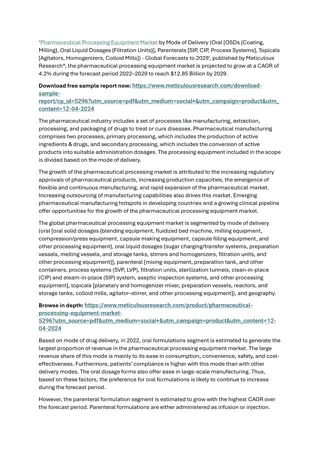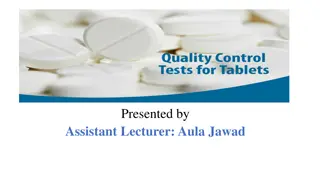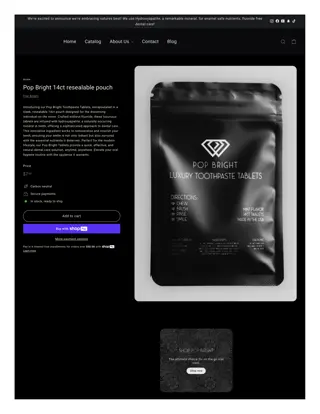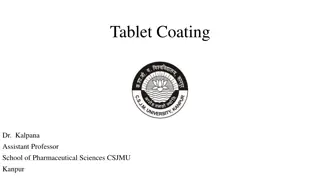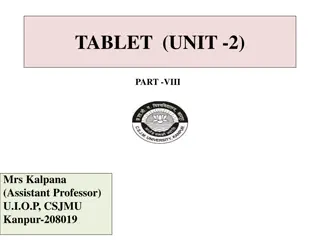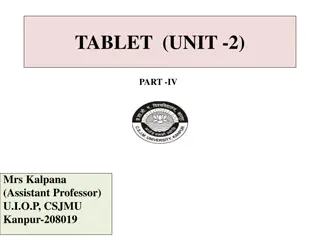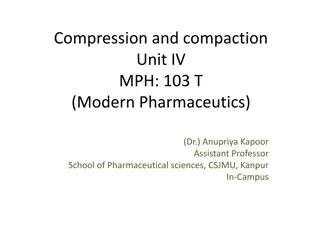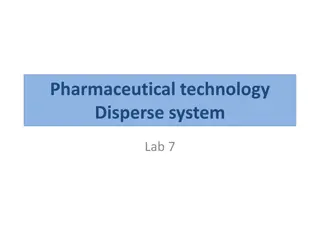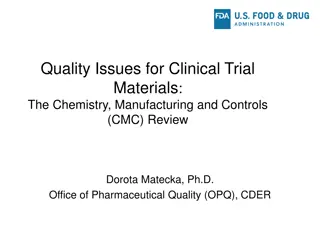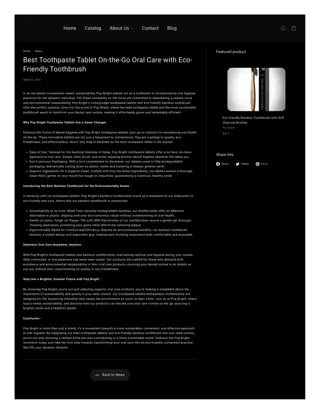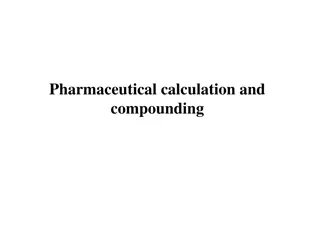Pharmaceutical Tablet Testing Procedures and Considerations
This informative content delves into weight variation, content uniformity, and disintegration tests conducted in pharmaceutical laboratories. It discusses official testing methods, factors affecting test outcomes, and requirements for ensuring potency uniformity and tablet quality. Content covers weight variation allowance, content uniformity factors, and the importance of disintegration tests for ensuring drug availability in the body. Detailed guidelines and considerations are provided for each test, emphasizing the critical role they play in pharmaceutical quality control.
Download Presentation

Please find below an Image/Link to download the presentation.
The content on the website is provided AS IS for your information and personal use only. It may not be sold, licensed, or shared on other websites without obtaining consent from the author. Download presentation by click this link. If you encounter any issues during the download, it is possible that the publisher has removed the file from their server.
E N D
Presentation Transcript
Weight variation, content uniformity &Disintegration test (official test) Lab 6 1
Pharmacopeial or official tests: A- Weight variation Allowance 10% 7.5% 5% The limited weight variation according to USP: Average wt. (mg) mg Less than 130 More than 324 mg 130-324mg Take 20 tabs and weigh individually and calculate the average weight and compare the individual tab. Weight with the average then no more than 2 tabs should be outside percentage limit.
Note: Wt. variation method used to determine drug content uniformity, if powder of tab. Contain 90-95% active ingredient, while wt. variation test is not sufficient to assure potency uniformity for moderate to low dose drugs in which excipients make up the bulk of the tab. weight. Factors affecting wt. variation: Segregation of the powder Poor flow Poor mixing Variation in the adjustment of the upper and lower punch Use of insufficient quantity of lubricant
4 7/28/2024 Content uniformity test: Factors contribute directly in content uniformity problems of tablet: 1- Non-uniform distribution of the drug substance throughout the powder mixture or granulation. 2- segregation of the powder mixture or granulation during various manufacturing process. 3- Tablet wt. variation.
5 7/28/2024 Notes: 1. Content uniformity or wt. variation for highly active ingredient tablets 90-95% having no problems to calculate. 2. Small dose drug having problem of content uniformity and wt. variation so each calculate individually. Content uniformity for low dose drugs (to assure uniform potency): Test 30 tablets by randomly selected for the sample. At least 10 tablets of them assayed individually (nine of them must contain not less than 85% or more than 115% of the labeled drug content. The tenth tab. Must not be less than 75% or more than 125% of the labeled content), if these conditions not met then the remaining 20 tablets is individually assayed and non of them falls outside the range of 85-115%
6 Disintegration test (U.S.P.) : For a drug to be readily available to the body , it must be in solution. For most tablets, the first important step toward solution is break down of the tablet into smaller particles or granules, a process called disintegration.
8 Disintegration test apparatus
10 Complete disintegration: is a state in which any residue remain is a soft mass having no palpable firm core except fragments of insoluble coating remaining on the screen of the apparatus. Procedures are stated for running disintegration times for (uncoated tablets, plain coated tablets, enteric coated tablets, buccal tablets and sublingual tablets). Uncoated USP tablets have disintegration time as low as 5 minutes, but the majority have max. disintegration time of 30 minutes.
11 7/28/2024 To be in compliance with USP standards, the end time of the test at which all parts of the tablet must disintegrate and pass (eliminated) through the mesh screen (from the set of tubes) in which the tabs held during agitation (lowering and rising process). The lowering and rising process (agitation) held at constant frequency (28-32 cycle)/min in such away that the highest position of the tubes ensure that the screen remain below the surface of water. Note: Enteric coated tablets are similarly tested. Except that the tablets are tested in simulated gastric fluid for one hour, after which no sign of disintegration, cracking or softening must be seen. They are immersed in simulated intestinal fluid for the time specified in the monograph, during which time the tablets disintegrate completely for a positive test.
12 7/28/2024 Disintegration time: The U.S.P. device (disintegrator) uses 6 glass tubes that are 3 inches long; open at the top and 10 mesh screen at the bottom end. To test for disintegration time, one tablet is placed in each tube and the basket rack is positioned in a 1-L beaker of water, simulated gastric fluid or simulated intestinal fluid at 37 20 C such that the tablet remain 2.5 cm below the surface of liquid on their upward movement and not closer than 2.5 cm from the bottom of the beaker in their downward movement. Move the basket containing the tablets up and down through a distance of 5-6 cm at a frequency of 28 to 32 cycles per minute. Floating of the tablets can be prevented by placing perforated plastic discs on each tablet.
13 7/28/2024 Disintegration test: (Experiment done 3 times)we start with 6 tablets (each tablet in each tube), if one or two tablets failed to disintegrate completely, test should be repeated for additional 12 tablets, the requirement met if not fewer than 16 of the total 18 are disintegrated. Note:The rationale for using disintegration test is the fact that as the tablet breakdown into small granules, it offers a greater surface area to the dissolving media and thus must be related to the availability of the drug in the body. But this test offers no assurance that the resultant particles will release the drug in solution at appropriate rate, that s why the dissolution test has been developed.
14 7/28/2024 Factors affecting the disintegration time Content : especially the quantity and quality of the disintegrant and lubricant (mixing condition and time of addition of lubricant), the lubricant increase the disintegration time by decreasing the wettability of the tablets due to its hydrophobicity. Hardness: amount of binder , compression force. Design of granulation procedure which will affect the physical properties of the granules.
15 7/28/2024


